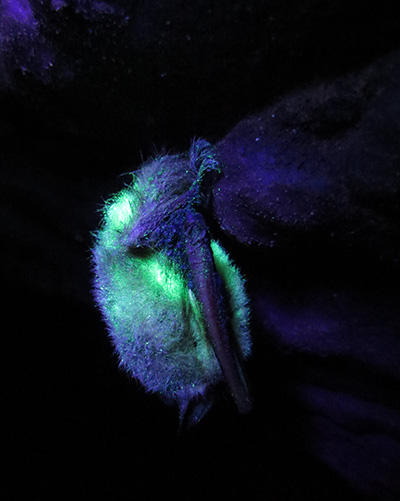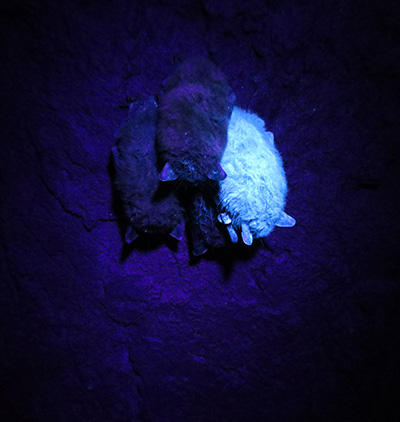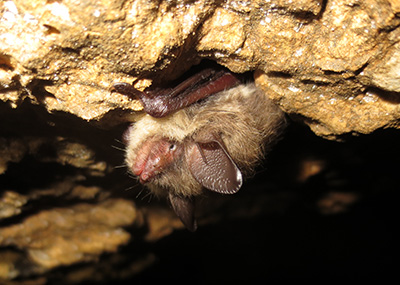A new study of disease transmission in bats has broad implications for understanding the hidden connections that can spread diseases between species and lead to large-scale outbreaks.
By dusting bats with a fluorescent powder that glows under ultraviolet light, scientists at the University of California, Santa Cruz, were able to trace the dynamics of disease transmission in bat species that have been devastated by the fungal disease known as white-nose syndrome. Their findings were published November 19 in Nature.
"These results uncovered connections both within and among species that we never knew about before," said first author Joseph Hoyt, who led the study as a UC Santa Cruz graduate student and is now at Virginia Polytechnic Institute.
"We had been seeing explosive epidemics where an entire population would become infected within a month or two, and it was a mystery how that was happening," he said.
Coauthor A. Marm Kilpatrick, associate professor of ecology and evolutionary biology at UC Santa Cruz, said infrequent and indirect connections among individuals play a far larger role in disease transmission than is generally recognized.
"When we think about who we might get sick from, we tend to think of family and friends or coworkers. But there's also that brief interaction with the barista at Starbucks, or the doorknobs you've touched and the shared airspace on the subway," Kilpatrick said. "People are aware of those things, but not how important they are. Their role in epidemics is poorly understood because they are so hard to quantify."
Spillover
Spillover events, when pathogens spread from wild animals to human populations, tend to occur through these kinds of cryptic connections, he noted. "We don't normally appreciate how important they are except retrospectively, when we investigate outbreaks of diseases like Ebola or SARS," he said.
The fluorescent dust used in this study proved to be highly effective at revealing previously unrecognized connections among the bats. The researchers conducted the study at eight hibernation sites (mostly abandoned mine tunnels) in the upper Midwest. Each site had as many as four species of bats using it. At the start of the study, the pathogen that causes white-nose syndrome had not yet reached these populations.
The researchers first surveyed the bats and characterized their social networks, measuring direct physical contacts between bats hibernating together in groups, as well as additional connections made by bats moving between groups. Then they applied the fluorescent dust to selected bats in early winter, using a different color for each individual. In late winter, the researchers returned to see where each color of fluorescent dust ended up.
"The spread of the dust mirrors how the fungal pathogen spreads, and we can see if a bat deposits dust somewhere in the environment and another bat passes through and picks it up. It also reveals infrequent direct contacts that we would not normally observe," Hoyt said.
Transmission dynamics
The fungus that causes white-nose syndrome arrived in the area after the fluorescent dust studies were conducted, and the researchers tracked its spread at each site. They found that the actual transmission dynamics of the disease were better explained by the sum of all the connections revealed in the dust studies than by just using the social networks seen in hibernation groups.
"We were able to explain the actual invasion of the pathogen much better by including those cryptic connections, and they were even more important for explaining transmission between species than for transmission within species," Hoyt said.
One of the puzzling features of white-nose syndrome is its ability to spread through a community of bats during the winter, when the animals are hibernating 99.5 percent of the time. They rouse from hibernation only very briefly every two to three weeks. Yet the dust studies show they move around enough to have many more connections than can be observed in their hibernation groups.
Most striking were the cryptic connections revealed for one species, the northern long-eared bat, which roosts by itself, not in groups. Although classical theory would predict low infection rates for this solitary species, it has been hard hit by white-nose syndrome.
"When we put fluorescent dust on the northern long-eared bat, it would show up on other species that we had never seen them interact with. We would never have predicted that the infection could spread by that route," Hoyt said.
Kilpatrick noted that a different solitary species, the tri-colored bat, has a lower infection rate and showed less evidence of cryptic connections with other bats, although it did transfer dust to surfaces in the sites where it roosts. "It's not that it doesn't rouse and crawl around, it just does so in a home range that has less overlap with other bats, so there may be more territoriality in its use of space," Kilpatrick said.
Unfortunately for bats, the spores of the fungal pathogen that causes white-nose syndrome persist in the environment and remain infectious for years. Once the walls and ceiling of a cave have been contaminated with the spores, bats using the site for hibernation will be exposed to infections year after year.
"That contrasts with common human diseases like flu and colds. It's true that contact with a doorknob can transmit these viruses, but the viruses don't survive on those surfaces for very long," Kilpatrick said. "One reason white-nose syndrome has been so devastating to bats is that it can survive on surfaces for years, so indirect contacts are really important."
The UC Santa Cruz researchers are part of a coordinated response to white-nose syndrome involving state and federal agencies, universities, and nongovernmental organizations.
In addition to Hoyt and Kilpatrick, the coauthors of the paper include Kate Langwig at Virginia Tech; Paul White, Heather Kaarakka, and Jennifer Redell at the Wisconsin Department of Natural Resources; Allen Kurta at Eastern Michigan University; John DePue and William Scullon at the Michigan Department of Natural Resources; Katie Parise and Jeffrey Foster at the University of New Hampshire; and Winifred Frick at Bat Conservation International and UC Santa Cruz. This work was supported by the National Science Foundation, U.S. Fish and Wildlife Service, and Bat Conservation International.





